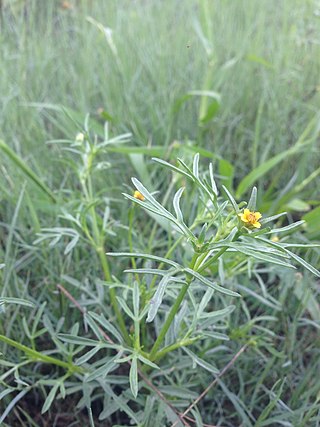
Antonio José Cavanilles was a leading Spanish taxonomic botanist, artist and one of the most important figures in the 18th century period of Enlightenment in Spain.

Galinsoga parviflora is a species of herbaceous plant in the daisy family Asteraceae. It has several common names including guasca (Colombia), pacpa yuyo, paco yuyo, and waskha (Peru), burrionera (Ecuador), albahaca silvestre and saetilla (Argentina), mielcilla, piojito, galinsoga, gallant soldier, quickweed, and potato weed.

Mutisia is a genus of flowering plant in the tribe Mutisieae within the family Asteraceae. Mutisia has been named after José Celestino Mutis. It comprises about sixty species which can be found along the entire length of the Andes and in southern Brazil, Paraguay, Uruguay and northern Argentina.

Ismene, or Peruvian daffodil, is a genus of South American plants in the Amaryllis family. The species are native to Peru and Ecuador and widely cultivated elsewhere as ornamentals because of their large, showy flowers.

Salvia polystachia, also spelt Salvia polystachya, is a herbaceous perennial native to central Mexico and south through Central America into Panama, typically growing at elevations from 5,000 to 10,000 feet in mild climates where there is some summer rain. It is one of the species used as chia and it is rarely seen in horticulture.

Zuccagnia punctata is a species of flowering plant in the family Fabaceae. It is the sole species in genus Zuccagnia. It belongs to tribe Caesalpinieae of subfamily Caesalpinioideae.

Heterosperma is a genus of flowering plants in the sunflower family, native to North and South America.

Mastigostyla is a genus of flowering plants in the family Iridaceae, first described as a genus in 1928. The entire group is endemic to South America. The genus name is derived from the Greek words mastigos, meaning "whip", and stylos, meaning "style".

Maurandya is a genus of flowering plants in the family Plantaginaceae, native to Mexico and the south west United States. They sprawl or climb by means of twining leaf stalks. One of the four species, Maurandya barclayana, is widely cultivated as an ornamental plant.

Pyrolirion, commonly known as fire lilies or flame lilies, is a small genus of herbaceous, bulb-forming South American plants in the Amaryllis family, native to Chile, Peru, and Bolivia.

Stenomesson is a genus of bulbous plants in the family Amaryllidaceae. All the species are native to western South America.

Clinanthus is a genus of bulbous plants in the family Amaryllidaceae. It is found in western South America, including Ecuador, Peru, Bolivia, north Chile and north west Argentina.

Phycella is a genus of herbaceous, perennial bulbous flowering plants belonging to the family Amaryllidaceae, subfamily Amaryllidoideae. The genus consists of five species distributed from central Chile to northwestern Argentina.

Hippeastrum pardinum is a flowering perennial herbaceous bulbous plant, in the family Amaryllidaceae, from Peru to Bolivia. Originally collected in 1866 by Richard Pearce, it was used in breeding programmes.

Paramongaia is a genus of South American plants in the Narcissus Family ( Amaryllidaceae), the most important species being Paramongaia weberbaueri found only in the Andes of Peru and Bolivia. Common names are "giant Peruvian daffodil." and Cojomaria. Its appearance resembles the "King Alfred" Daffodil, but the flower is up to 7.25 inches in length by 7.5 inches wide with a corona 3.3 inches by 3 inches long by three inches wide.

Hieronymiella is a genus of flowering plants in the Amaryllis family. It is native to Bolivia, north-western Argentina, and southern Peru.

Larrea divaricata, commonly known as chaparral, is a small evergreen bush in the family Zygophyllaceae. It is native to arid regions of South America, where it is known as jarilla or jarillo. It was first described in 1800 by the Spanish botanist Antonio José Cavanilles.

Heterosperma pinnatum, the wingpetal, is a New World species of plants in the family Asteraceae. It has a discontinuous distribution in North and South America, having been found in Bolivia, Venezuela, Mexico, Guatemala, Honduras, and the south-western United States.

Famatina was a small genus of South American bulbous plants identified by the Chilean botanist Ravenna in 1972. Five species have been described. Molecular phylogenetic studies suggested the genus was polyphyletic, and species have been moved to other genera.

Eustephieae is a flowering plant tribe in the family Amaryllidaceae, subfamily Amaryllidoideae. It forms part of the Andean clade, one of two clades in The Americas.




















